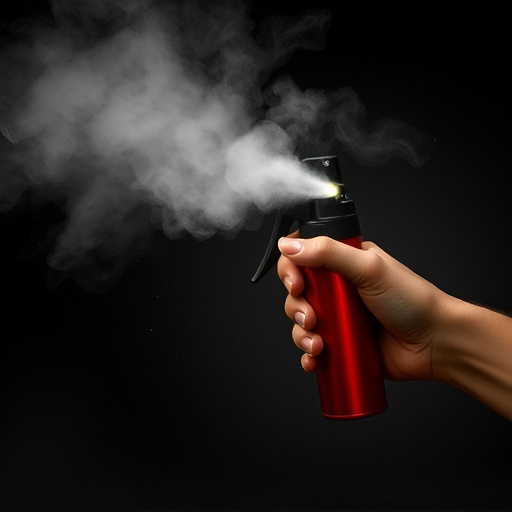Pepper Spray Wind Direction Tips are essential for safe and effective crowd control. Calm conditions improve spray precision, while strong winds make its trajectory unpredictable. Law enforcement should consider wind strength and direction, use protective gear, train in proper spraying techniques (aiming low), and conduct drills with varying wind scenarios to minimize off-target effects and ensure public safety.
“In recent years, pepper spray has emerged as a significant tool in crowd control tactics employed by law enforcement agencies worldwide. With its ability to temporarily incapacitate individuals, it offers a strategic advantage in managing large gatherings. However, understanding the nuances of its application is paramount for effective and safe deployment. This article explores the use of pepper spray, focusing on key factors like wind direction and best practices. By delving into these aspects, we aim to provide valuable tips (Pepper Spray Wind Direction Tips) for optimized results while mitigating potential concerns.”
- Understanding Pepper Spray as a Crowd Control Measure
- The Role of Wind Direction in Pepper Spray Effectiveness
- Best Practices for Safe and Effective Use of Pepper Spray
- Potential Concerns and Countermeasures for Pepper Spray Deployment
Understanding Pepper Spray as a Crowd Control Measure
Pepper spray, officially known as oleoresin capsicum (OC) spray, is a non-lethal crowd control measure used by law enforcement agencies worldwide. It works by irritating the eyes and respiratory system, temporarily disabling individuals and allowing officers to gain control of potentially violent situations. When deployed, understanding the pepper spray wind direction tips becomes crucial for both effectiveness and safety.
The wind plays a significant role in determining where the spray will land. Optimal conditions are when there is no wind or a light breeze blowing away from the target. This ensures that the spray stays focused on the intended individuals rather than spreading to bystanders or reflecting back at the officers. In higher wind speeds, the spray’s trajectory becomes unpredictable, making it less effective and potentially causing harm to innocent people.
The Role of Wind Direction in Pepper Spray Effectiveness
The wind direction plays a significant role in determining the effectiveness and reach of pepper spray during crowd control situations. When deployed, pepper spray particles are designed to disperse and drift, aiming to incapacitate individuals within a targeted area. However, understanding the wind’s behavior is crucial for optimal results and safety. For instance, in calm or still conditions, the spray can quickly accumulate in a specific area, potentially leading to excessive exposure for bystanders or even law enforcement officers.
Conversely, an easterly or westerly breeze can help dissipate the spray more evenly, ensuring it covers a larger zone without concentrating in one place. This is particularly useful when dealing with large crowds spread over an open space. Pepper spray wind direction tips suggest that law enforcement agencies should consider deployment strategies based on real-time weather data and the specific layout of the venue. By accounting for wind patterns, officers can maximize the spray’s impact while minimizing its unintended effects.
Best Practices for Safe and Effective Use of Pepper Spray
When employing pepper spray for crowd control, understanding the wind direction tips is paramount to ensure safety and effectiveness. Officers should consistently consider the direction and strength of the wind before deploying the spray. A gentle breeze can carry the spray away from its intended target, reducing its impact, while a stronger gust could blow it back towards the users, posing a risk to their own safety.
Best practices dictate that officers aim pepper spray at the legs or mid-torso of individuals, ensuring they do not directly target faces or heads. This tactic minimizes the chance of accidental inhalation by those in close proximity and reduces potential long-term eye damage. Additionally, training should emphasize responsible use, including proper ventilation, wearing protective gear, and being prepared to offer medical aid if needed following deployment.
Potential Concerns and Countermeasures for Pepper Spray Deployment
When deploying pepper spray for crowd control, understanding the wind direction is paramount. One of the primary concerns with pepper spray is off-target effects; it can easily blow back onto officers or bystanders if not used correctly. To mitigate this risk, law enforcement should consider the following tips: assessing and accounting for the prevailing wind direction before deploying the spray to ensure it doesn’t bounce back towards them or innocent citizens. Additionally, using protective gear such as goggles and face masks is crucial to safeguard against accidental inhalation or eye irritation.
Moreover, tactical training on appropriate spraying techniques is essential. Officers should be taught to aim low, towards the legs of agitated individuals, to de-escalate situations without endangering others. Regular drills in simulated conditions with varying wind patterns can help prepare officers for unpredictable environments, ensuring they use pepper spray responsibly and effectively while minimising potential harm and negative impacts on public safety.
Pepper spray, when used responsibly, can be an effective crowd control measure. Understanding its impact is key, especially considering the wind direction, which significantly affects its effectiveness. By adhering to best practices and being aware of potential concerns, law enforcement can ensure safe and strategic deployment. These tips highlight the importance of thorough training and continuous evaluation for optimal results when employing pepper spray as a last resort during crowd management.
